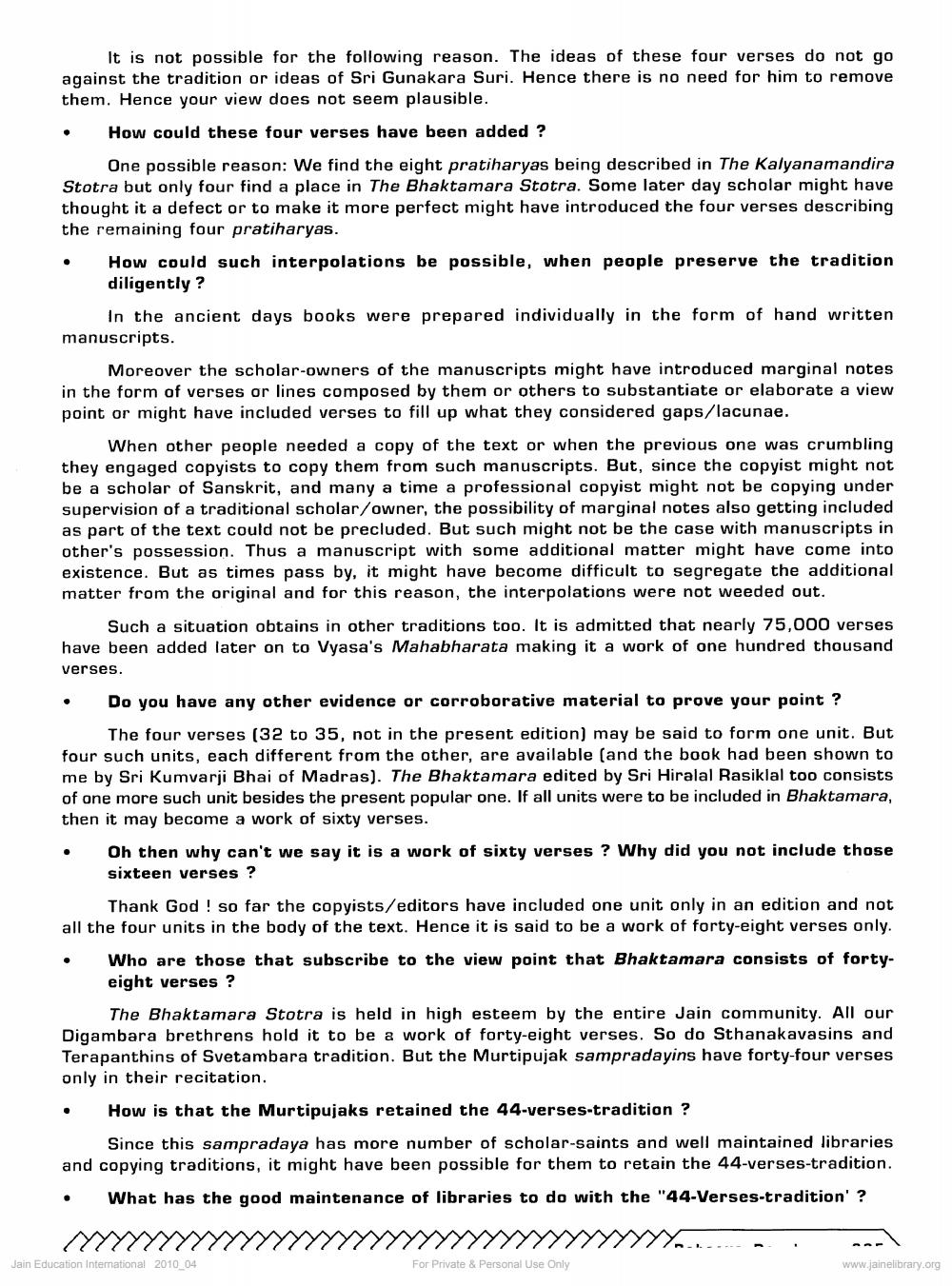________________
It is not possible for the following reason. The ideas of these four verses do not go against the tradition or ideas of Sri Gunakara Suri. Hence there is no need for him to remove them. Hence your view does not seem plausible.
• How could these four verses have been added ?
One possible reason: We find the eight pratiharyas being described in The Kalyanamandira Stotra but only four find a place in The Bhaktamara Stotra. Some later day scholar might have thought it a defect or to make it more perfect might have introduced the four verses describing the remaining four pratiharyas.
How could such interpolations be possible, when people preserve the tradition diligently?
In the ancient days books were prepared individually in the form of hand written manuscripts.
Moreover the scholar-owners of the manuscripts might have introduced marginal notes in the form of verses or lines composed by them or others to substantiate or elaborate a view point or might have included verses to fill up what they considered gaps/lacunae.
When other people needed a copy of the text or when the previous one was crumbling they engaged copyists to copy them from such manuscripts. But, since the copyist might not be a scholar of Sanskrit, and many a time a professional copyist might not be copying under supervision of a traditional scholar/owner, the possibility of marginal notes also getting included as part of the text could not be precluded. But such might not be the case with manuscripts in other's possession. Thus a manuscript with some additional matter might have come into existence. But as times pass by, it might have become difficult to segregate the additional matter from the original and for this reason, the interpolations were not weeded out.
Such a situation obtains in other traditions too. It is admitted that nearly 75,000 verses have been added later on to Vyasa's Mahabharata making it a work of one hundred thousand verses.
Do you have any other evidence or corroborative material to prove your point ?
The four verses (32 to 35, not in the present edition) may be said to form one unit. But four such units, each different from the other, are available (and the book had been shown to me by Sri Kumvarji Bhai of Madras). The Bhaktamara edited by Sri Hiralal Rasiklal too consists of one more such unit besides the present popular one. If all units were to be included in Bhaktamara, then it may become a work of sixty verses
Oh then why can't we say it is a work of sixty verses ? Why did you not include those sixteen verses ?
Thank God! so far the copyists/editors have included one unit only in an edition and not all the four units in the body of the text. Hence it is said to be a work of forty-eight verses only.
Who are those that subscribe to the view point that Bhaktamara consists of fortyeight verses ?
The Bhaktamara Stotra is held in high esteem by the entire Jain community. All our Digambara brethrens hold it to be a work of forty-eight verses. So do Sthanakavasins and Terapanthins of Svetambara tradition. But the Murtipujak sampradayins have forty-four verses only in their recitation.
How is that the Murtipujaks retained the 44-verses-tradition ?
Since this sampradaya has more number of scholar-saints and well maintained libraries and copying traditions, it might have been possible for them to retain the 44-verses-tradition.
What has the good maintenance of libraries to do with the "44-Verses-tradition' ?
wwwxxxxXXXXXXXXXXXXxxxxxxxxxxxxxxXY
Jain Education International 2010_04
For Private & Personal Use Only
www.jainelibrary.org




